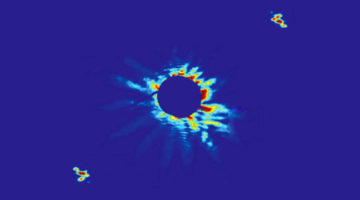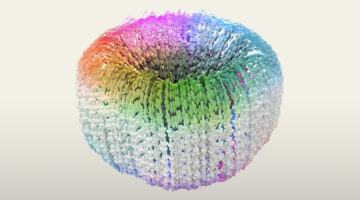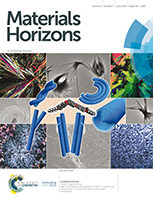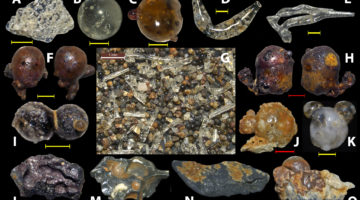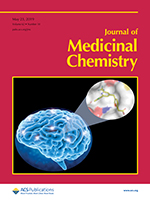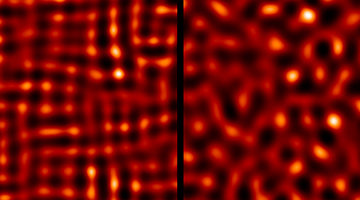Like a tiny needle in a sprawling hayfield, a single crystal grain measuring just tens of millionths of a meter— found in a borehole sample drilled in Central Siberia—had an unexpected chemical makeup. And a specialized x-ray technique in use at the ALS confirmed the sample’s uniqueness and paved the way for its formal recognition as a newly discovered mineral: ognitite. Read more »
ALS Work Using Scattering/Diffraction
These techniques make use of the patterns of light produced when x-rays are deflected by the closely spaced lattice of atoms in solids and are commonly used to determine the structures of crystals and large molecules such as proteins.
A Crackling Analysis of Stripe and Skyrmion Phases
Through statistical analysis of “crackling” (a system’s jerky response to slowly changing conditions), researchers demonstrated fundamental differences between skyrmion and stripe phases in a layered heterostructure. The method has broad applicability to many complex materials of interest for emerging information technologies. Read more »
Electric Dipoles Form Chiral Skyrmions
Researchers demonstrated that polar skyrmions—cousins of magnetic skyrmions but comprising swirls of electric dipoles instead of spins—exhibit chirality in a material with electrically switchable properties. Control of such phenomena could one day lead to low-power, nonvolatile data storage as well as to high-performance computers. Read more »![]()
![]()
Heliconical-layered nanocylinders (HLNCs) – hierarchical self-assembly in a unique B4 phase liquid crystal morphology
Morphology is of critical importance for molecular crystals, drug molecules, alloys, and elements in the periodic table. We here demonstrate how very subtle structural changes in a set of bent-core liquid crystals lead to rather complex hierarchical superstructures driven by changes in molecular conformation. Read more »
Breakthrough in Membrane-Protein Design Settles Long-Standing Debate
Scientists characterized designed membrane proteins to better understand the forces that stabilize these large, complex structures. The results necessitate a rethinking of membrane-protein biophysics and could lead to better therapies for related illnesses as well as functional membrane proteins for engineering applications. Read more »![]()
![]()
Study Concludes Glassy Menagerie of Particles in Beach Sands Near Hiroshima is Fallout Debris from A-Bomb Blast
Mario Wannier was methodically sorting through particles in samples of beach sand from Japan’s Motoujina Peninsula when he spotted something unexpected: a number of tiny, glassy spheres and other unusual objects. X-ray studies have provided evidence that they are A-bomb fallout from the destroyed city of Hiroshima. Read more »
Self-Assembling 2D Arrays with de Novo Protein Building Blocks
Modular self-assembly of biomolecules in two dimensions (2D) is straightforward with DNA but has been difficult to realize with proteins, due to the lack of modular specificity similar to Watson–Crick base pairing. Here, researchers describe a general approach to designing 2D arrays using de novo designed pseudosymmetric protein building blocks. Read more »
Exploring the “minimal” structure of a functional ADAMTS13 by mutagenesis and small-angle X-ray scattering
Researchers used the SIBYLS beamline to gain insight into ADAMTS13, the only known protein to regulate the adhesive function of von Willebrand factor (VWF), a blood-clotting protein. When VWF is deficient or abnormal, it causes a common inherited bleeding disorder, von Willebrand disease. VWF is also implicated in arterial and deep-vein thrombosis, stroke, atherosclerosis, sickle cell crisis, and sepsis. Read more »
Design and Synthesis of Selective Phosphodiesterase 4D (PDE4D) Allosteric Inhibitors for the Treatment of Fragile X Syndrome and Other Brain Disorders
PDE4D enzymes are important for normal brain function. Mutations have been asssociated with an ultrarare neurodevelopmental disorder, and genetic variation in PDE4D contributes to biological variation in human cognitive ability. Here, researchers report on novel PDE4D inhibitors providing potent memory-enhancing effects in a mouse model, with improved tolerability and reduced vascular toxicity over earlier PDE4 inhibitors. Read more »
Superconductor Exhibits “Glassy” Electronic Phase
Researchers discovered that electrons in a high-temperature superconductor can exhibit a new type of collective behavior that is more “glassy” (disordered) than expected. The study provides valuable insight into the nature of collective electron behaviors and how they relate to high-temperature superconductivity. Read more »![]()
![]()
- « Previous Page
- 1
- …
- 23
- 24
- 25
- 26
- 27
- …
- 39
- Next Page »

